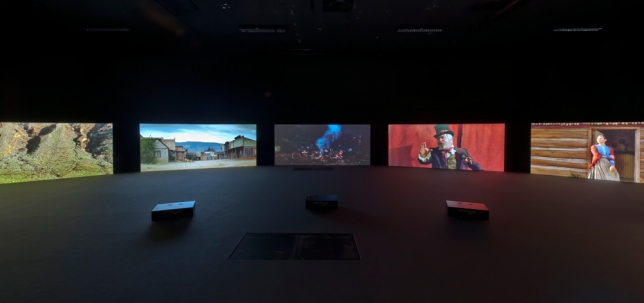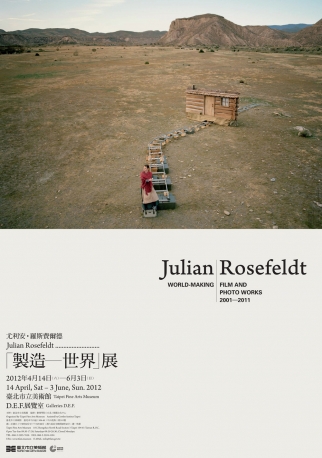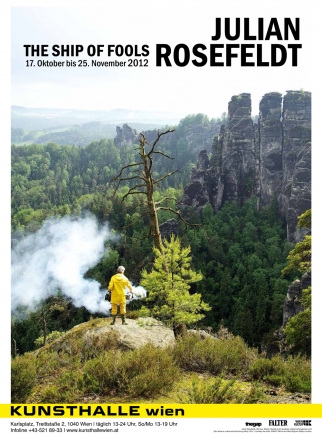Julian Rosefeldt
Born in 1965 in Munich, Germany
Lives and works in Berlin, Germany
The artist has made a name for himself with lavishly produced 16mm and 35mm films. Projected onto several screens to create a panorama-like effect, his films carry the viewer off into a surreal, theatrical world whose inhabitants are caught in the structures and rituals of everyday life. In what are probably his best known film installations, Trilogie des Scheiterns (Trilogy of Failure, 2004–2005), Rosefeldt dealt with universal themes like the absurdity of human existence, approaching them with slapstick humour and plumbing their deeper philosophical meaning. His most recent film installation American Night takes on decidedly more political issues: Using the stylistic devices of the Western genre, he deconstructs the myth of the founding of America and relates it to the hegemonic ambitions of recent US foreign policy. Like his earlier works, this latest work is rife with biting satirical humour.
Almost all his works are characterised by their complex interweaving of several dimensions of reality, a device he uses to expose the production process. In American Night and The Soundmaker (Trilogy of Failure, Part 1, 2004), for example, he has the camera zoom out so far in an extreme long shot that the film set comes into view. Thus, his films are also always a homage to the medium of film and a reflection on the construction of fictional narratives using cinematographic and iconographic means.
Recent solo exhibitions include: "Julian Rosefeldt: Manifesto", European Capital of Culture, Aarhus, Denmark (2017), "Julian Rosefeldt, Works 2001-2016", Nikolaj, Kunsthal Copenhagen, Denmark (2017), "Manifesto de Julian Rosefeldt", Ecole des Beaux Arts de Paris, Paris, France (2017), "Julian Rosefeldt: Deep Gold", Galería Helga de Alvear, Madrid, Spain (2017), "Manifesto", Villa Stuck, Munich, Germany (2017), "Manifesto", Staatsgalerie Stuttgart, Stuttgart, Germany (2016), "Manifesto", Park Avenue Armory, New York, USA (2016), "Manifesto", Ruhrtriennale 2016, Duisburg, Germany (2016), "Asylum", Centrum Kultury Nowy Teatr Warsaw, Warsaw, Poland (2016), "Manifesto", Art Gallery of New South Wales, Sydney, Australia (2016), "American Night", Kemper Art Museum, St. Louis, MO, USA (2016), "Manifesto", Hamburger Bahnhof – Museum für Gegenwart, Berlin, Germany (2016), "Asylum", Herzliya Museum of Contemporary Art, Herzliya, Israel (2016), "Manifesto", Australian Centre for Moving Image (ACMI), Melbourne, Australia (2015), "Deep Gold", Landesgalerie Linz, Linz, Austria (2015), "Die Schöpfung / In the Land of Drought", Ruhrtriennale 2015, Duisburg, Germany (2015).
Rosefeldt has participated in numerous international group exhibitions art institutions worldwide that include: "The Inner Skin: Art and Shame", Marta, Herford, Germany (2017), "Cinema mon Armour: Film in Art", Aargauer Kunsthaus and the Solothurn Film Festival, Aarau, Switzerland (2017), "House of Impressions. Wandering with a Troubadour", Pushkin State Museum of Fine Arts, Moscow, Russia (2016), "Performing the Landscape", Illingworth Kerr Gallery / Alberta College of Art and Design, Calgary, Canada (2016), "Zeitgeist: The Art of New Berlin", CCBB, Brazil (2016), "Moving Time: Video Art at 50: 1965-2015", CAFA Art Museum, Beijing, China (2016), "Fireflies in the Night Take Wing", Stavros Niarchos Foundation Cultural Center (SNFCC), Athens, Greece (2016), "Elective Affinities", Arsenals Exhibition Hall / The Latvian National Museum of Art, Riga, Latvia (2016), "The difference between sunrise and sunset", Schloss Tüssling, Munich, Germany (2016), "130% Sprengel. Sammlung Pur", Sprengel Museum Hannover, Hannover, Germany (2016), "One Artist's One Screen", Solyanka State Gallery, Moscow, Russia (2016), "Homosexuality_ies", LWL – Museum für Kunst und Kultur Münster, Münster, Germany (2016), "Double Act", MAC Belfast, Belfast, Ireland (2016), "Wolfsburg Unlimited", Kunstmuseum Wolfsburg, Wolfsburg, Germany (2016), "TELE-GEN. Art and TV", Kunstmuseum Liechtenstein, Vaduz, Liechtenstein (2016), "Zeitgeist: the Art of New Berlin", CCBB, Rio de Janeiro, Brazil (2016), "Zeitgeist: The Art of New Berlin", CCBB, Belo Horizonte, Brazil (2015), "Moving Time: Video Art at 50, 1965-2015", The Eli and Edythe Broad Museum, MI, USA, (2015), "About Trees", Zentrum Paul Klee, Bern, Switzerland, (2015), "The art of storing", Draiflessen Collection, Mettingen, Germany (2015), "TELE-GEN. Art and TV", Kunstmuseum Bonn, Germany (2015), "Et in Arcadia Ego", Museum Kurhaus Kleve, Kleve, Germany (2015), "Homosexuality_ies", Schwules Museum & Deutsches Historisches Museum, Berlin, Germany (2015), "NGORONGORO. Artistweekend 2015", Lehderstrasse 34, Berlin, Germany (2015), "Conflict, Time, Photography", Museum Folkwang, Essen, Germany (2015), "Conflict, Time, Photography", Tate Modern, London, UK (2014), "4th Mediations Biennale", When Nowhere Becomes Here. Berlin Heist, Poznan, Poland (2014), "Fear & Desire", Young Projects, Los Angeles, USA (2014), "Broken. Slapstick, Comedy und schwarzer Humor. Sammlung Goetz im Haus der Haus der Kunst", Haus der Kunst, Munich, Germany (2014), "Der Stachel des Skorpions" at the Villa Stuck München, Munich, Germany (2014), "Kino der Kunst" at the MaximiliansForum, Munich, Germany (2013), "Julian Rosefeldt: The Ship of Fools" at Kunsthalle Wien, Austria (2012) and "American Night. Filminstallationen 2008-2011" at the Bayerische Akademie der Schönen Künste, Munich, Germany (2012), "Making Of: Film Installations and Photo Works 2004-2010" at the DA2 DOMUS ARTIUM, Salamanca, Spain (2010/11), "American Night" at the British Film Institute, London, UK (2010), "Living in Oblivion" at the Berlinische Galerie, Berlin, Germany (2010), "American Night: Film Installations 2004–2009" at the Kunstmuseum Bonn, Germany (2009), "The Perfectionist" at Platform China, Contemporary Art Institute, Beijing, China (2007), "asylum" at Haus der Kunst, Munich, Germany (2005) as well as at Hamburger Bahnhof, Berlin, Germany (2002), "Trilogy of Failure" at Kunst-Werke Berlin, Germany (2004), "Global Soap" at the Künstlerhaus Bethanien, Berlin, Germany and the Goethe-Institut, Salvador de Bahia, Brasilia as well as at the Herzliya Museum of Contemporary Art, Tel Aviv, Israel (all 2001).
His film Lonely Planet, for which he received the Filmstiftung NRW Award in the international competition of the KunstFilmBiennale Köln, Germany in 2007, was been shown at the „Cinéma Prospectif“ of the Centre Pompidou in Paris, France (2009).
EXHIBITIONS:
10.06. – 27.08.10
Julian Rosefeldt
“Photo Works”
at ARNDT, Berlin
29.4. - 30.5.2010
“Changing The World”
Group exhibition wirh works by Erik Bulatov, Sophie Calle, William Cordova, Wim Delvoye, Anton Henning, Thomas Hirschhorn, Ilya und Emilia Kabakov, Jitish Kallat, Jon Kessler, Karsten Konrad, Julije Knifer, Enrique Martinez Celaya, Josephine Meckseper, Vik Muniz, Muntean Rosenblum, Julian Rosefeldt, Charles Sandison, Dennis Scholl, Nedko Solakov, Hiroshi Sugito, Ena Swansea, Mathilde Ter Heijne, Keith Tyson, Ralf Ziervogel
at ARNDT, Berlin
02.05.–16.05.2009
Julian Rosefeldt
"American Night"
Arndt & Partner, Berlin, Halle am Wasser
CATALOGUE AVAILABLE
20.4. - 16.05.2008
Julian Rosefeldt
"The Ship of Fools"
Solo exhibitionat Arndt & Partner,Berlin
30.05. – 22.06.2006
Julian Rosefeldt
“Lonely Planet”
at Arndt & Partner, Berlin
03.02. – 10.03.2005
Julian Rosefeldt
“The Soundmaker“
at Arndt & Partner, Zurich
Further books and catalogues:
FILM WORKS
ASYLYM
 Julian Rosefeldt & Piero Steinle, Detonation Deutschland 5b, 1999, b/w photographs Lambda-Prints, Dia-Sec-framing, Framed 120 x 90 cm | 47.24 x 35.43 in 1/6 from an edition of 6 + 2AP, # ROSE0050-2
Julian Rosefeldt & Piero Steinle, Detonation Deutschland 5b, 1999, b/w photographs Lambda-Prints, Dia-Sec-framing, Framed 120 x 90 cm | 47.24 x 35.43 in 1/6 from an edition of 6 + 2AP, # ROSE0050-2
Mär 24, 2010
JULIAN ROSEFELDT is the winner of this year’s Vattenfall Contemporary 2010
The prize is assigned in cooperation with the Berlinische Galerie, Berlin, and includes not only an acquisition by the art collection of Vattenfall but also considers a solo exhibition with the artist at the Berlinische Galerie accompanied by a publication. The opening of the exhibition and the award ceremony takes place on Friday, 30 April 2010 at 7 p.m. at the Berlinische Galerie
-------------------------------------------------------------------------------------------------------------------------------
Sep 21, 2010
"American Night" at BFI London, until 6 November 2010
Julian Rosefeldt's film installation 'American Night' | BFI London, until 6 November 2010
---------------------------------------------------------------------------------------------------
Jan 3, 2011
Solo exhibition at DA2 DOMUS ARTIUM 2002, Salamanca
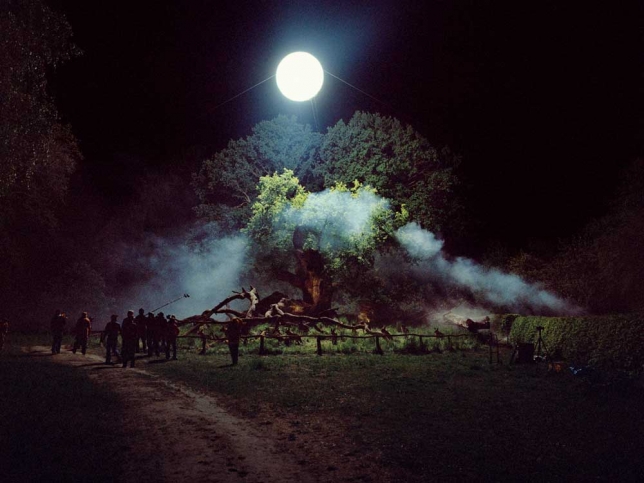 Julian Rosefeldt, Making Of (The Ship of Fools), 2007, From the series: Making Of Lightjet print 60 x 80 cm | 23.62 x 31.5 in, framed 62 x 82 cm | 24.41 x 32.28 in 1/6 from an edition of 6 + 2AP, # ROSE0135
Julian Rosefeldt, Making Of (The Ship of Fools), 2007, From the series: Making Of Lightjet print 60 x 80 cm | 23.62 x 31.5 in, framed 62 x 82 cm | 24.41 x 32.28 in 1/6 from an edition of 6 + 2AP, # ROSE0135
EXHIBTION EXTENDED UNTIL 06 MARCH 2011!
7 October 2010 - 16 January 2011
Julian Rosefeldt's films carry the viewer away into a surreal, theatrical world whose inhabitants are caught in the structures and rituals of everyday life. Despite their enigmatic subject matter and the precision of their production, Rosefeldt’s films are charged with slapstick and satire.
In “Making Of” eight film installations by Julian Rosefeldt will be accompanied by 40 photographic works, illustrating his opulent film work created since 2001. The exhibition sheds light on central themes and motifs, and traces the development of the artist’s oeuvre.
---------------------------------------------------------------------------------------------------------------------------------
Aug 2, 2011
"American Night" at the Australian Centre for the Moving Image (acmi) in Melbourne from 21 June to 31 July 2011
 Julian Rosefeldt, American Night (II -VII)2009, 2009, from the film: American Night (set of 9 motives), framed each 55 x 90 cm | 21.65 x 35.43 in
Julian Rosefeldt, American Night (II -VII)2009, 2009, from the film: American Night (set of 9 motives), framed each 55 x 90 cm | 21.65 x 35.43 in
Exhibition runs Tuesday 21 June – Sunday 31 July, 2011
A five channel installation that embraces the conventions of the Western film genre, American Night (2009) deconstructs the myths surrounding the foundation of America and offers a scathing commentary on recent US foreign policy.
Entry is free. For further information visit www.acmi.net.au
----------------------------------------------------------------------------------------------------------------------------------
Aug 24, 2011
Premiere at the Jewish Museum Berlin: Meine Heimat ist ein dunkles wolkenverhangenes Land
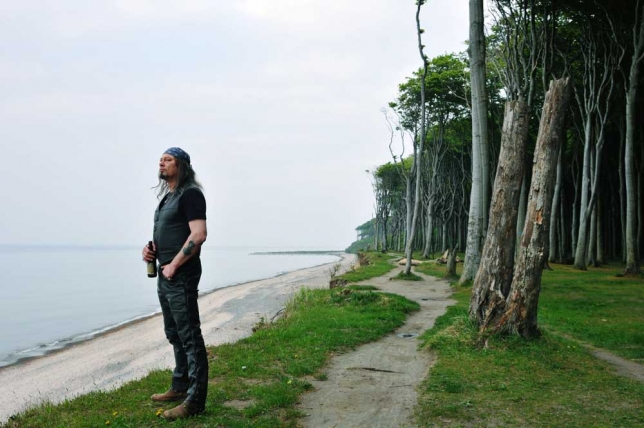 Julian Rosefeldt, My home is a dark and cloud-hung land, 2011, 4-channel film installation, HD, transfered to HD-SR and BluRay disc, Aspect ratio 16:9, Loop ca. 30 min
Julian Rosefeldt, My home is a dark and cloud-hung land, 2011, 4-channel film installation, HD, transfered to HD-SR and BluRay disc, Aspect ratio 16:9, Loop ca. 30 min
On the occasion of the group exhibition "How German is it?" at the Jewish Museum Berlin the new four-channel film installaton „My home is a dark and cloud-hung land" by Julian Rosefeldt will be on view. The exhibition runs from from 16 September 2011to 29 January 2012.
30 Artists' Notion of Home
Celebrating Ten Years of the Jewish Museum Berlin
The exhibition "How German is it?" shows works by 30 artists on topics such as family and collective memories, national myths, religion and experiences of migration. Room installations, video- and filmworks, photo series, paintings and graphic prints will be presented. Among the artists are Via Lewandowsky, Julian Rosefeldt, Paul Brody, Arnold Dreyblatt, Misha Shenbrot, Anny and Sibel Öztürk and Raffael Rheinsberg and Lilly Engel, who have been commissioned to produce pieces for this exhibition.
---------------------------------------------------------------------------------------------------------------------------------
Sep 1, 2011
Group show "Star Voyager" at acmi, Melbourne
22 September 2011- 29 January 2012
Journey through the fact and fiction of space exploration from Fritz Lang to the moon landing, to Star Trek and Avatar.
ACMI presents the world premiere of Star Voyager: Exploring Space on Screen, a major exhibition charting the history and future of space exploration as experienced through the moving image.
From early films by Fritz Lang and Georges Méliès, through to footage of the 1969 moon landing and recent films such as the Alien series, Moon and Sunshine, the moving image has allowed us to experience what most of us can only dream of.
Combining scientific and documentary footage with feature films and video artwork, the Star Voyager exhibition celebrates an enduring fascination with space travel through the imaginations of artists, scientists and astronauts.
Enjoy a rare opportunity to see real NASA artefacts used in space plus film production materials, including costumes from Star Trek, Austin Powers and Total Recall. The exhibition also features an exciting new work, developed here in Melbourne, allowing visitors to explore the surface of Mars in 3D.
---------------------------------------------------------------------------------------------------------------------------------
Okt 9, 2012
Julian Rosefeldt Solo Show 'The Ship of Fools' at Kunsthalle Wien, Oct - Nov 2012
Apr 27, 2014
SPECIAL SCREENING | Julian Rosefeldt | May 1, 2014 | The Scorpion's Sting | An exquisite corpse based on Luis Buñuel's L'Âge d'or
Exhibitions
10.06. - 27.08.2011
Julian Rosefeldt
Photo Works
Solo presentation at ARNDT, Berlin
ARNDT is delighted to announce the first solo presentation of the photographic work by Julian Rosefeldt in Berlin.
The exhibition will run from 9 June (until 9 p.m.) until 27 August.
Julian Rosefeldt frequently has his films projected onto several screens simultaneously, carrying the viewer off into a surreal, theatrical world whose inhabitants are caught in the structures and rituals of everyday life. Despite their enigmatic subject matter and the precision of their production, Rosefeldt’s films are charged with slapstick and satire. “This work,” wrote Stephan Berg, “is succinct because it avoids political correctness and plays with the vocabularies of kitsch, inappropriateness, and exaggeration. It demonstrates what it really means to distort—in the best sense of the word—the world to a point where it is no longer recognizable.”
With movie stills and behind-the-scenes photos Rosefeldt sheds light on his central themes and motifs.
Besides participating in numerous international group exhibitions he presented solo shows in galleries and art institutions worldwide, e.g. 2010/11 at DA2 DOMUS ARTIUM 2001, at Salamanca, the BFI London (2010) at the Berlinische Galerie (2010) at the Kunstmuseum Bonn (2009), Platform China Contemporary Art Institute, Beijing (2007); Haus der Kunst, Munich (2005), Kunst-Werke Berlin (2004); Hamburger Bahnhof, Berlin (2002); and the Herzliya Museum of Art, Tel Aviv, Israel (2001). His film Lonely Planet, for which he received the Filmstiftung NRW Award in the international competition of the KunstFilmBiennale Köln in 2007, has been shown at the „Cinéma Prospectif“ of the Centre Pompidou in Paris (2009).
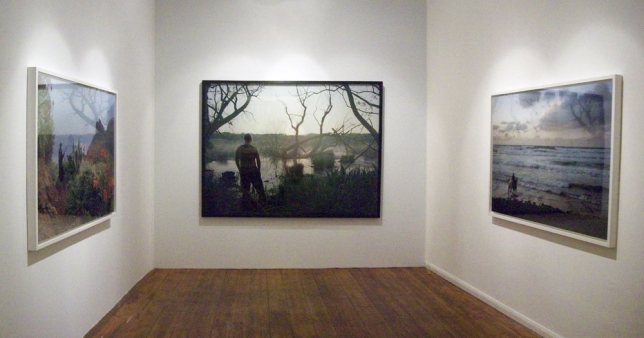 Ausstellungsansicht Julian Rosefeldt, 2011, ARNDT Berlin 2011
Ausstellungsansicht Julian Rosefeldt, 2011, ARNDT Berlin 2011
 Ausstellungsansicht Julian Rosefeldt, 2011, ARNDT Berlin 2011
Ausstellungsansicht Julian Rosefeldt, 2011, ARNDT Berlin 2011
 Ausstellungsansicht Julian Rosefeldt, 2011, ARNDT Berlin 2011
Ausstellungsansicht Julian Rosefeldt, 2011, ARNDT Berlin 2011
02.05.–16.05.2009
Julian Rosefeldt
"American Night"
Solo exhibition at Arndt & Partner, Berlin
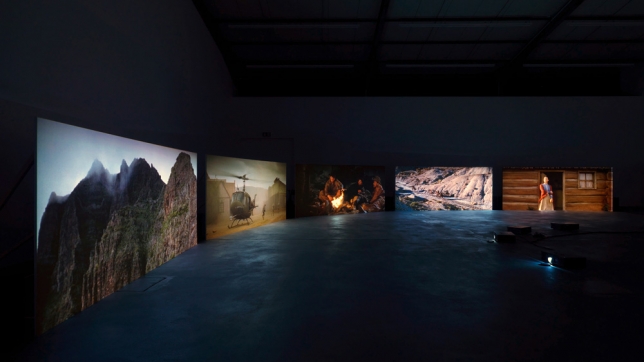 Julian Rosefeldt "American Night" Solo exhibition at Arndt & Partner, Berlin
Julian Rosefeldt "American Night" Solo exhibition at Arndt & Partner, Berlin
PRESS RELEASE
During the Gallery Weekend Berlin we will be presenting a sneak preview of American Night by Julian Rosefeldt. The five-channel film installation is one of the biggest and most complex works to date by the Berlin-based artist, who has made a name for himself with lavishly produced films projected onto several screens to create a panorama-like effect. The German museum premiere of American Night, which was filmed in southern Spain and the Canary Islands, will take place as part of an extensive solo exhibition of Rosefeldt’s work at the Kunstmuseum Bonn this fall.
In what are probably his best known film installations, Trilogie des Scheiterns (Trilogy of Failure, 2004-2005), Rosefeldt dealt with more universal themes like the absurdity of human existence, approaching them with slapstick humour and plumbing their deeper philosophical meaning. American Night takes on decidedly more political issues: Using the stylistic devices of the Western genre, he deconstructs the myth of the founding of America and relates it to the hegemonic ambitions of recent US foreign policy. This latest work, too, is rife with biting satirical humour. In a sequence projected onto the fourth screen, George W. Bush and Barack Obama appear as the protagonists in a puppet show performed in a saloon. The farce culminates with Obama fatally shooting Bush – much like the plot of a conventional Western, in which the establishment of a new, supposedly more civil order comes about through armed force. On another screen, five cowboys are gathered around a campfire, musing on the American conception of freedom, the right to bear arms and – stepping outside their roles for a moment of self-reflexivity – on the Western as a genre. Every sentence uttered during their conversation is a quotation; some are taken from films, others from song lyrics, still others from the mouths of prominent US politicians. Among those quoted are filmmakers Sam Peckinpah and Jean-Luc Godard, rapper 50 Cent as well as actor and NRA president Charlton Heston.
These somewhat boisterous sequences are framed by quiet, tableau-like scenes that transport the viewer to the stereotypical Wild West of a long bygone era. We see the deserted main street of a Western town where the only movement is the fluttering of a curtain in the wind or a tumbleweed rolling by. Another scene shows a cowboy riding through hilly countryside in blinding sunlight. After a while, though, the apparent familiarity of these images begins to unravel: The cowboy’s ride ends in front of an endless ocean – a scene that breaks with the conventions of the Western and evokes the paintings of the German Romantic artist Caspar David Friedrich. The contemplative, melancholy cowboy staring at the sea is hard to reconcile with the familiar image of the rugged Western hero forever pressing forward into unknown territory. Events in the deserted Western movie set take an unexpected turn as well: In a comically absurd scene and winking reference to certain US foreign policy decisions, a helicopter lands and armed US troops rush out to occupy the town, as if it were Fallujah or Baghdad.
Another aspect that American Night shares with some of Rosefeldt’s earlier installations is its complex interweaving of several dimensions of reality, a device he uses to expose the production process. Thus, as in The Soundmaker (Trilogy of Failure, Part 1, 2004), he has the camera zoom out so far in an extreme long shot that the film set comes into view. The action in Rosefeldt’s film Lonely Planet (2006) took place on a Bollywood film set and in a cinema; similarly, the events in American Night play out on a theatre stage and a Western film set. The title American Night itself is a multiple reference: It alludes to the title of Francois Truffaut’s La nuit américaine (1974), which in turn refers to the cinematographic technique Day for Night. Often employed in Westerns, it involves the use of special filters to allow “night scenes” to be shot during the day. Rosefeldt uses the technique as well, and much like Truffaut’s film, which is about the making of another movie, his work is an homage to the medium of film and a reflection on the construction of fictional narratives using cinematographic and iconographic means.
Text by Kristin Rieber
Camera: Christoph Krauss
Production design: Ina Timmerberg
Costume design: Bina Daigeler
Puppetry: Suse Wächter
Editing: Heike Parplies
Production manager: Sandi Knape
Featuring: Priscilla Bergey, Maurice Brink, Jeff Burrell, Laura Cameron, Jeff Caster, Lisa Densem, Erik Hansen, Errol T. Harewood, Melissa Holroyd, Robert Kovacs, Grayson Millwood, Janaina Pessoa, Tammi von Sperber, Suse Wächter, Gavin Webber, Tim Williams, Jeff Wood, et al.
American Night was produced with support from the Second Biennial of the Canary Islands and the Kunstmuseum Bonn.
JULIAN ROSEFELDT
Born in Munich in 1965, Julian Rosefeldt lives and works in Berlin. He has had numerous solo exhibitions in galleries and art institutions in Asia, Europe and the US, e.g. at Phillips de Pury, New York (2007/08); Platform China Contemporary Art Institute, Beijing (2007); Kunst-Werke Berlin (2004); Hamburger Bahnhof, Berlin (2002); and the Herzliya Museum of Art, Tel Aviv (2001). He has also participated in many group exhibitions, including The Cinema Effect: Illusion, Reality and the Moving Image, Smithsonian – Hirshhorn Museum and Sculpture Garden, Washington DC (2008); Made in Germany, Kunstverein Hannover (2007); International Biennale of Contemporary Art, Prague (2005); the São Paolo Biennial (2004); and Deep Storage – Arsenale der Erinnerung (shown at Haus der Kunst, Munich and P.S.1 Contemporary Art Center, New York, among others, 1997–1999). His film Lonely Planet, for which he received the Filmstiftung NRW Award in the international competition of the KunstFilmBiennale Köln in 2007, will be shown at the Centre Georges Pompidou in Paris from 15 to 17 May 2009.
 "American Night" catalogue edited by Kunstmuseum Bonn in cooperation with EX3-Centro per l’Arte Contemporanea, Florenz, Publisher: The Green Box, Berlin 2009; Language: English/German/Italien Hardcover, 112 pages, 140 colour plates; with contributions by Stephan Berg, Lorenzo Giusti and Arabella Natalini ISBN 978-3-941644-15-1
"American Night" catalogue edited by Kunstmuseum Bonn in cooperation with EX3-Centro per l’Arte Contemporanea, Florenz, Publisher: The Green Box, Berlin 2009; Language: English/German/Italien Hardcover, 112 pages, 140 colour plates; with contributions by Stephan Berg, Lorenzo Giusti and Arabella Natalini ISBN 978-3-941644-15-1
20.4. - 16.05.2008
Julian Rosefeldt
"The Ship of Fools"
Solo exhibitionat Arndt & Partner,Berlin
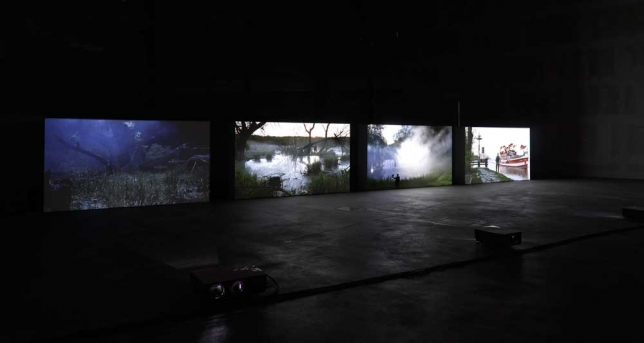 "The Ship of Fools", installation view at Arndt & Partner, 2008
"The Ship of Fools", installation view at Arndt & Partner, 2008
PRESS RELEASE
The Ship of Fools (2007) – filmed on the grounds of the Baroque manor Schloss Sacrow, purchased by Frederick William IV in 1840 – that grapples with the metamorphosis and continuity of German national sentiment from the Romantic era through National Socialism, from the former East Germany to the neo-Nazis of today. On four projection blocks standing side by side, melancholy scenes reminiscent of Caspar David Friedrich slowly unfold, almost motionless, to the accompaniment of baying sheepdogs. It is both a brooding, skeptical epitaph on more than two hundred years of German sensitivities and a murky allegory of the perpetual repetition of the ever same, fated to stay in the same rut forever, which has its formal correspondence in the protagonist staring into the far distance, rooted to the spot, and the tableau’s agitated immobility.
This is the pessimistic conclusion of the work: that there is no teleological development, no all-encompassing meaning, and no binding order in this world or beyond it and that we are obliged to remain in the infinite loop of our monadic existence and its own meaninglessness. With their pronounced systematic and documentary approach, the earlier works – created as a collaboration of equals with Piero Steinle – form, as it were, the necessary counterpoint. In Stadt im Verborgenen (1994), a search for the hidden impact of the Third Reich on the urban context of present-day Munich; in the surveying of industrial and post-industrial sites in Munich and Paris in Die unbekannten Kathedralen/Les Cathédrales Inconnues (1995/97); and in the ‘media archaeology’ of News (1998) and Global Soap (1999), Rosefeldt proves to be an explorer of fundamental, underlying structures, a detective on the trail of the invisible but powerful.
This introduction is an excerpt from the text "PLAY IT AGAIN" by Stephan Berg, from the catalogue "Julian Rosefeldt: Film Works" published by Hatje Cantz with further texts from Anselm Franke, Katerina Gregos and David Thorp. The catalogue presentation will take place in the Project Space on Sunday 4 May 2008 from 11am – 3pm. We look forward to welcoming you either on this occasion, or throughout the course of the weekend.
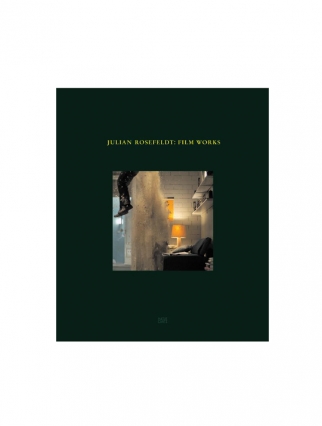 Julian Rosefeldt - Film Works, Publisher: Hatje Cantz, Ostfilern, 2008, Language: English, With contributions by Stephen Berg, Anselm Franke Katerina Gregos and David Thorp; Published with support by Arndt & Partner; ISBN: 978-3-7757-2171-4
Julian Rosefeldt - Film Works, Publisher: Hatje Cantz, Ostfilern, 2008, Language: English, With contributions by Stephen Berg, Anselm Franke Katerina Gregos and David Thorp; Published with support by Arndt & Partner; ISBN: 978-3-7757-2171-4
30.05. – 22.06.06
Julian Rosefeldt
“Lonely Planet”
Solo exhibition at Arndt & Partner, Berlin
PRESS RELEASE
Julian Rosefeldt's films possess a complex visual quality. The viewer is immersed in lavishly staged sets, which are projected in cinematographic style onto several canvases. Caught in a continuous loop, his protagonists move in heavy rhythms, matched by the action of the camera gliding slowly forwards and backwards. Rosefeldt treats everyday rituals and clichés analytically and ironically, subverting them by shifting the action into the absurd.
Shown in Berlin for the first time is the third part of the "Trilogie des Scheiterns" (Trilogy of Failure) - a series of films which deals with people's futile striving towards control. "The Perfectionist" shows on the left hand canvas a man caught up in a perpetual inspection of his parachute. Instead of stepping out and flying, this cross-checking becomes an obsessive act: the parachutist has become Sisyphus. Parallel to this on the right hand canvas, the same actor can be seen, as he simulates the parachute drop at home on his ironing board. The ridiculousness of the heavy man on the fragile domestic appliance is underlined by a fog machine being switched on, which all of a sudden can't be turned off. Thereupon an aircraft turbine rushes into the room - while on the left hand canvas a storm starts to blow, which welds the man to his inflated parachute.
The central picture of the installation meanwhile remains quiet: in a cockpit a pilot flicks a multitude of switches with a practised hand, without however any discernible result. Rosefeldt underscores the absurdity of automatic processes and compulsive behaviour: The dream of flight flounders on the emptiness of ritual. Sisyphus becomes Icarus. The artist's most recent work "Lonely Planet", uses the figure of an ambitious backpacker on a trip through India, played by the artist himself, in order to challenge the way that images and clichés are formed. His journey takes him from romanticised motifs to the slums of Bombay. Here the scene suddenly shifts from a fictitious narrative to the reality of filmic scenesetting: the tourist emerges as a performer amongst cameras and spotlights - the dirty metropolis gives way to the artificial and illusory atmosphere on the set. A putatively authentic India reverts to the realm of Bollywood, culminating in a musical interface from the film. Finally on this meta-level the current Indian clichés of chaos, kitsch and call-centres dissolve into a surreal choreography.
The installation was commissioned by the Bonn Biennial and was realised as a co-production between Arndt & Partner Berlin/Zurich, Max Wigram, London, the Goethe-Institute New Delhi and Festival Lille 3000. Postproduction of the exhibited works was generously supported by werk novalisstrasse, Berlin. We also wish to especially thank Thomas Olbricht Collection which co-financed the production of "The Perfecionist" and Rumi Verjee for his support.
Julian Rosefeldt, born in 1965 in Munich, lives and works in Berlin. He has had solo shows in famous institutions such as Kunst-Werke Berlin (2004) and Hamburger Bahnhof, Berlin (2002) and has taken part in numerous group shows, including the 26th São Paolo Biennale (2004), the Centre Georges Pompidou, Paris (2002), Kunsthalle Basel (2000) and PS.1, New York (1998). "The Soundmaker", the first part of the Trilogy of failure will be presented from 1 June to 16 July 2006 at the Akademie der Künste, Berlin as part of the festival "sonambiente".
Text: Gesine Borcherdt
03.02. – 10.03.2005
Julian Rosefeldt (GER)
“The Soundmaker“
Solo exhibition at Arndt & Partner, Zurich
PRESS RELEASE
We are pleased to announce the foundation of Arndt & Partner AG in Zurich and the opening of our new gallery space. In the 10th year of Arndt & Partner we seek to expand our radius of communication. On 150 square metres space, located at Lessingstrasse 5, we shall present our gallery artists, who are not yet represented in Switzerland, as well as using it as a platform for younger positions.
The first exhibition will be a double premiere: the film and photo works by Julian Rosefeldt will be shown in Switzerland for the first time. This show also announces the inclusion of the Berlin-based artist into our gallery program.
In his first solo exhibition at Arndt & Partner, Zurich, Julian Rosefeldt presents a selection of film stills as well as his film installation "The Soundmaker" - the first part of his recent film series "Trilogy of Failure".
Similar to his earlier works, the films from "Trilogy of Failure" are conceived as dipty- or triptychons, for which the individual projections are precisely synchronised with one another. The viewer is immersed into a cinematic scenery in which the narratives of Julian Rosefeldt's elaborately finished super 16 mm films unfold in loops without beginning or end. "Trilogy of Failure" explores the structures and routines that organize our everyday existence.
The installation "The Soundmaker" is presented as three channel projection. Shot from two different camera angles, the two outer film sequences observe a sound maker at work in his cramped, improvised studio. The projection in the middle seemingly depicts the scene, for which the sounds are being created. The protagonist of this film sequence, who is identical with the sound maker, is assembling the entire furniture as well as every item he can find in his studio apartment into a single pile in the middle of the room.
The assumption that one was watching a filmmaker in the process of producing the soundtrack for his own film becomes uncertain as both protagonists suddenly leave their rooms, withdrawing for a short moment from the camera's sight. It seems as if they changed place. Is the sound maker now finding himself in the apartment, while the other character is in the sound studio? Why does the person in the apartment move all the items and furnishings from the meticulously stacked pile back to their original position? One begins to ponder, whether the actions determine the sound or whether it may be the other way around. Increasingly, the familiar changes into the surreal.
Julian Rosefeldt employs the technique of the swaying or slowly forth and back moving camera. Furthermore he avoids any narrative cuts, thus achieving the impression that his protagonists are inescapably trapped in the absurd cycle of their monotonous activities. "The Soundmaker" as well as "Stunned Man" (the second part of "Trilogy of Failure"), from which some of the exhibited film stills originate, can be read as philosophy in moving pictures. Julian Rosefeldt's films display a satirical humour and a great sensitivity for ambiguity as they revitalize existentialist interpretations of the sisyphos metaphor and critically reflect upon the filmic medium.
Julian Rosefeldt, born in 1965 in Munich, Germany, lives and works in Berlin. He presented solo exhibitions in renowned institutions, such as the KW - Institute for Contemporary Art, Berlin (2004), the Baltic Centre for Contemporary Art, Gateshead /Newcastle, Great Britain (2004), the Hamburger Bahnhof, Berlin (2002), as well as the Herzliya Museum of Art, Tel Aviv, Israel (2001). Furthermore, he participated in numerous group exhibitions, e.g. the 26th São Paulo Biennale (2004), at the O.K Centrum für Gegenwartskunst, Linz, Austria (2004), the Museum der Moderne, Salzburg, Austria (2004), the Centre Georges Pompidou, Paris (2002), the Kunsthalle Vienna (2001), the Kunsthalle Basel, Switzerland (2000), the Deichtorhallen, Hamburg, Germany (1999), or the P.S.1, New York (1998).
JULIAN ROSEFELDT
Meine Heimat ist ein düsteres, wolkenverhangenes Land
My home is a dark and cloud-hung land
Solo exhibition at ARNDT Berlin
July 16 – August 20, 2014
Opening reception | July 15, 2014 | 6-9 pm
PRESS RELEASE
ARNDT Berlin is delighted to present Julian Rosefeldt’s exhibition ‘My Home is a Dark and Cloud-Hung Land’ to mark the ten-year anniversary of the gallery’s partnership with the artist.
Since beginning his artistic career twenty years ago, Julian Rosefeldt, who has lived in Berlin since the late 1990s, has continually dealt with German history and approached questions of national identity and myths in photographs as well as film and video installations.
Europe is currently experiencing a resurgence of nationalist sentiments in an economic and social context that even shows disturbing parallels to the period between the two world wars. Economic stability within the European Union is out of balance, interest rates are at record lows, and those who benefit least from the advantages of the EU worry about their savings and what some see as excessive immigration. The imagined enemies in the minds of Euroskeptics and right-wing populists, which have recently helped Marine Le Pen, Geert Wilders and Nigel Farage achieve previously unimagined victories, are those who bear the brunt of globalization: refugees from countries in the former Third World. And even Germany, which so far seems to be least affected by the global economic crisis, has suddenly reemerged as a perceived enemy for a growing number of European citizens for the first time since the end of the Nazi era.
In the context of the current relevance of these issues, ARNDT Berlin will be showing a selection of photographic and film works, including the film installation ‘My Home is a Dark and Cloud-Hung Land, 2011’, which was co-produced by the Jewish Museum Berlin and is also the source of the exhibition’s title. This work was exhibited in early 2014 at the Kunstmuseum Magdeburg and was part of Rosefeldt’s major retrospective in 2012 at the Taipei Fine Arts Museum.
The current presentation will also feature the series of photographs ‘Hidden City, 1994/2010’, which will be on view this November at the Tate Modern in London. The series is a new collection of photographs that Rosefeldt originally took in 1994 and 1995 in the buildings of the former Nazi Party headquarters on the Königsplatz in Munich and in the surrounding area. On view will be also be the series ‘Detonation Deutschland, 1996’ (in collaboration with Piero Steinle), which shows demolitions of buildings in Germany from 1945 until the work’s creation in the mid-1990s. ‘Archive of Archives, 1995’ is a series of photographs, for which Rosefeldt visited and documented places of collecting in his native city of Munich.
Julian Rosefeldt (born 1965 in Munich), studied architecture in Munich and Barcelona (MA 1994). In 2009/2010 Rosefeldt was visiting professor at the Bauhaus-Universität in Weimar and since 2011 professor at the Akademie der Bildenden Künste in Munich. Since 2010 Rosefeldt is a member of the Bayrischen Akademie der Schönen Künste in Munich (department for film and media art). Rosefeldt lives and works in Berlin since 1999.
PRESS
Berliner Morgenpost | August 2014 | Ist unsere Heimat ein duesteres wolkenverhangenes Land
TAZ | July 2014 | Was kann der Wald denn nur dafür, dass er so schön ist
Die Welt Kompakt | July 2014 | Ist das nicht romantisch
ArtBerlin | July 2014 | Ist unsere Heimat ein duesteres wolkenverhangenes Land
FAZ | July 2014 | Ah diese Galerieluft
 Installation view I
Installation view I
 Installation view II
Installation view II
 Installation view III
Installation view III

